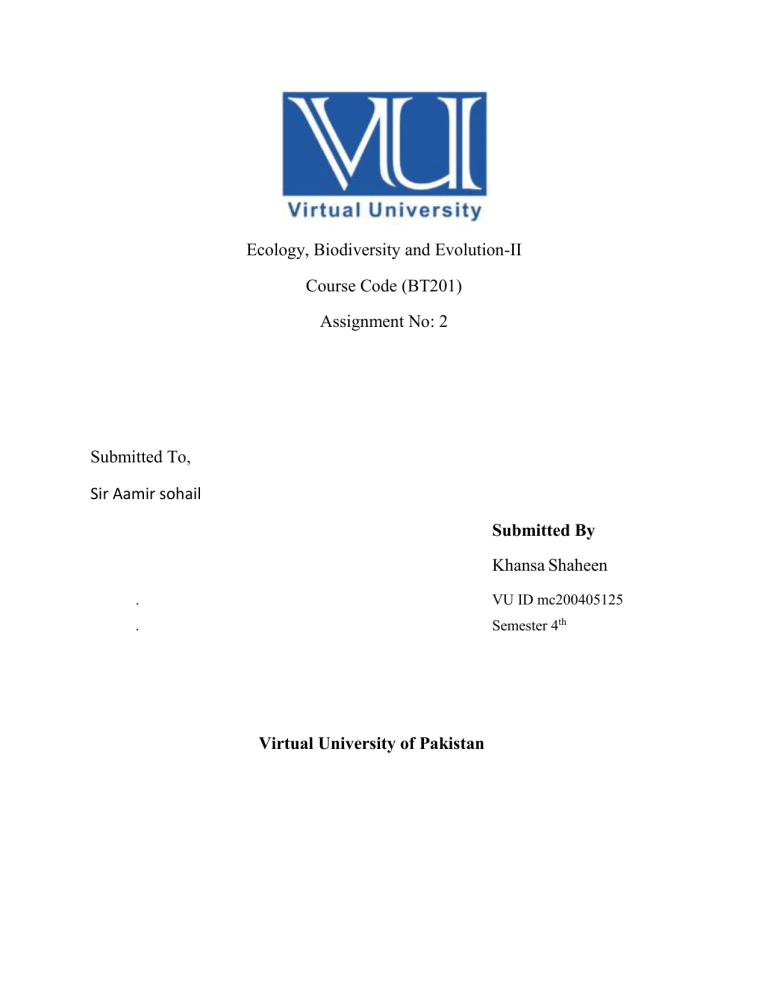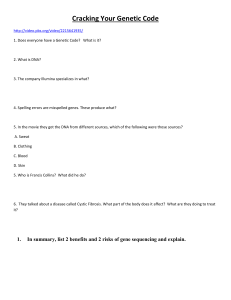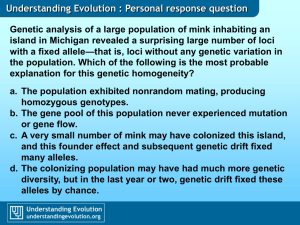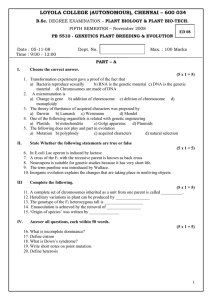
Ecology, Biodiversity and Evolution-II Course Code (BT201) Assignment No: 2 Submitted To, Sir Aamir sohail Submitted By Khansa Shaheen . VU ID mc200405125 . Semester 4th Virtual University of Pakistan Question #1: (A) How does genetic diversity occur in a population? Genetic diversity is the diversity of inheritable characteristics, active or inactive within species for example between person and population of the identical genus. The genetic variation occurs in a population through multiple factors. Some of these factors are shortly explained below: Migration: Migration is the movement of organisms from one place to another place. Even if it can occur in seasonal patterns (as it does in birds), migration when used in a population genetics context often refers to the movement of individuals into or out of a model population. If the migrating individuals rest and reproduce with the destination individuals, they can provide an unexpected inflow of alleles. After mating is established between the migrating and destination individuals, the migrating individuals will contribute gametes transfer alleles that can change the existing section of alleles in the destination population. Genetic Drift:(Random forces leads to genetic drift) Random movement in the number of alleles in a population, changes in relative allele frequency, called genetic drift, can either increase or decrease by chance over time. Generally, genetic drift occurs in small populations, where unusually alleles dial greater possibility of being lost. Once it begins, genetic drift will continue until the involved allele is either lost by a population or is the only allele present at a particular gene locus within a population. Both possibilities decrease the genetic diversity of a population. Genetic drift is common after a population experiences a population bottleneck. A population bottleneck arises when a remarkable number of individuals in a population die or otherwise prevent breeding. Genetic drift can result in the loss of alleles and can decrease the size of the gene pool. Genetic drift can also cause a new population to be genetically different from its original population, which has influenced to the hypothesis that genetic drift plays a role in the evolution of new species. Matting pattern: When people are divided, formal conflicts may sometimes occur because the living organism chooses to reproduce with other organism based on certain factors. In this, people in society make certain moral choices, and these choices shape the genetic makeup from successive generations. When this happens, the mating patterns of that figure are no longer random. Random mating can occur in two ways, with different consequences. Another type of random breeding is breeding, which occurs when people with the same genotype are at risk of breeding. (B) What is the role of mobile genetic elements in mobile genetic resistance? Mobile genetic elements (MGEs) A selfish gene is a type of gene that can travel around the genome or be transmitted from one gene or copy to another. All living things contain MGEs. MGEs are thought to make up around half of the human genome, with each MGE playing a different function in evolution. The MGE machine can also cause genetic events. MGEs can also cause mutations in protein code regions, which are responsible for protein functions. They are also capable of replicating genes in the host genome. One example of MGE in the evolutionary context is the transfer of virulence and genetic resistance to MGE drugs to neighboring viruses. This machine's newly found genes may raise the intensity of new or extra functionalities. MGEs, on the other hand, can lower inflammation by introducing disease-causing alleles or mutations of the MGE set into mobilize, a living creature composed of a vast number of plasmids, transposons, and bacteria. Examples Plasmids: These are frequently additional chromosomal DNA molecules that multiply and are transmitted in the absence of chromosomal DNA. They are found in prokaryotes (bacteria and archaea) and occasionally in eukaryotic species like yeast. During their life cycle, plasmids transfer genes from one species to another via a process known as mating. Furthermore, they frequently inject genes that make antibodies resistant to drugs. Cloning vectors: These are plasmid compounds that contain bacteriophages and are used to transfer and reproduce DNA fragments inserted utilizing DNA-assembled procedures. It must be able to duplicate itself and the fragment of DNA it carries in order to operate as a vector. Cosmides and Phagemids are two examples. Transposons: This is the DNA sequence that can migrate and reproduce in various areas of a cell gene. Also known as "jumping genes," they can be transported horizontally across species in symbiosis. Transposons are found in all living organisms, including viruses. DNA transposons are transposons that transfer from one location in the genome to another by employing transposase to cut and attach to another. Retrotransposons: These are transposons that migrate throughout the genome after being reverse transcribed into RNA and then into DNA. Eukaryotic cells are the only ones that contain retrotransposons. A family of small non-coding RNAs known as PIWI [P-element induced wimpy testis]-interacting RNAs (piRNAs) controls these retrotransposons. PiRNAs, which range in length from 24 to 32 nucleotides, are a type of ncRNAs that was just recently identified. Since transposable sequences in the genome are among the repetitive elements that piRNAs originate from, they were initially referred to as repeat-associated siRNAs (rasiRNAs). Viruses: These are viral agents made of a DNA or RNA molecule that may form complex particles called virions, allowing them to migrate freely between their hosts. All organisms that are living contain viruses. The host's replicative mechanism produces viral particles for horizontal transmission. Nucleic acids in orbit: These are DNA or RNA molecules that are required for the replication of certain helper viruses and are carried around as stowaways in their virions. They are not always present in their helper viruses, despite the fact that they are occasionally regarded as genetic components of such viruses. Viroids: These are viral agents that consist of circular RNA molecules that infect and replicate in plants. Endogenous viral element: These are viral nucleic acids that have been incorporated into a cell's genome. Without leading to disease or mutation, they can travel and duplicate several times in the host cell. They are regarded as independent transposons. Proviruses and endogenous retroviruses are two examples.







